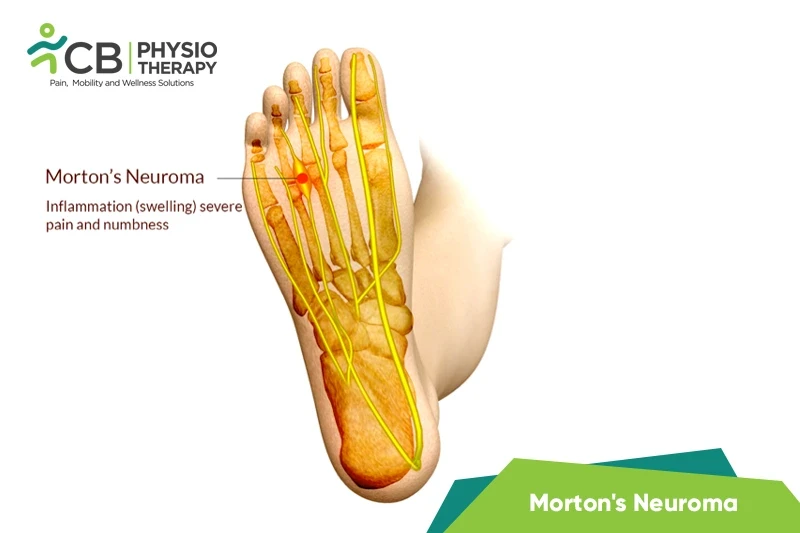
Morton's neuroma occurs when the nerve between the toe becomes inflamed and swollen. Symptoms of Morton's neuroma include pain between the toes and the feeling of stepping on a pebble. Morton's neuroma affects the forefoot or the ball of the foot, between the metatarsal bones and toes. It's also called intermetatarsal neuroma.
This condition develops when the nerve suffers excessive pressure or compression between the toes. It occurs more often in women than men, because of shoe styles and many more reasons like:
An irritated or damaged nerve between the toe bones causes Morton's neuroma. The compression or squeezing causes inflammation and irritation. Symptoms of Morton's neuroma get worse over time. Common symptoms of Morton's Neuroma include:
Pathology:
Morton's Neuroma involves the thickening and degeneration of the interdigital nerve of the foot, commonly between the third and fourth metatarsal heads.
Physical examination:
During an examination, the health provider will look at the feet, to check if there's a mass between the toes, and puts pressure on the spaces between the toe bones to check the location of the foot pain.
X-rays:
An X-ray doesn't show a neuroma but can help rule out other conditions that cause foot pain, such as arthritis or stress fracture.
Magnetic resonance imaging (MRI):
Magnetic resonance imaging of the foot provides a detailed picture of tissues and nerves and in getting a proper diagnosis.
Ultrasound:
Ultrasound gives real-time images of the internal structures of the foot and helps detect soft tissue abnormality.
Electromyography:
Electromyography helps to measure the electrical activity of the nerves and muscles. It can rule out nerve conditions that can cause symptoms similar to those of Morton's neuroma.
Medications: Nonsteroidal anti-inflammatory drugs (NSAIDs), steroid injections, Anti-inflammatory drugs injected into the skin, local anesthetic injection, etc.
Note: Medication should not be taken without the doctor's prescription.
Surgery:
If conservative treatment doesn't relieve the symptoms, then foot surgery such as neurectomy is recommended. Neurectomy is the most common surgery for Morton's neuroma, other procedures like cryogenic neuro ablation, radiofrequency ablation, etc can help reduce symptoms.
Rest and elevation:
Rest and elevation of the affected foot help to relieve the pressure on the compressed nerve.
Application of ice on the foot where there is a neuroma can subside the flare-up, especially after a long day of activities. Ice therapy significantly reduces inflammation and pain.
Heat therapy can be used by soaking the feet for 10 minutes and the pain magically disappears. This can be followed by massaging the feet and rubbing them with a pain ointment.
Therapeutic ultrasound is beneficial to decrease the associated inflammation and pain.
Extracorporeal Shockwave Therapy:
Extracorporeal Shockwave Therapy is a useful modality to reduce pain in patients with Morton's neuroma.
Footwear:
Shoes with the adequate room across the ball of the foot and in the toe are recommended. Foot pads and arch supports such as metatarsal pads fit inside the shoe and help reduce pressure on the nerve.
Orthotics:
Orthotics help with gait abnormalities, as gait abnormalities can lead to back pain, arthritis, or other problems. Orthotics are customized shoe inserts that can reduce some of the pain caused due to Morton's neuroma, by relieving the pressure from the painful nerve. Metatarsal pads in the shoe inserts and removable metatarsal pads can also offload the ball of the foot where there is pain.
The foot muscles are originally weaker, which is why Morton's neuroma has appeared. Strengthening exercises like balancing the foot, drawing the alphabet with the foot and many more can be done.
Stretching exercises:
Stretching exercises such as toe extensor stretch, lower foot, plantar fascia, and calf muscles regularly stretching can be carried on.
Deep tissue massage is applied with caution and utmost care to avoid aggravating the neuroma. Massage techniques are used to relieve pressure and compression on the metatarsal heads.
Manual therapy is effective in relieving pain, by altering afferent nociceptive barrages, normalizing sensorimotor mismatches, and activating descending anti-nociceptive pathways.
The patient is advised not to wear tight or high-heeled shoes for long periods, shoes with a wide toe box should be worn so that the toes aren't cramped. While playing, athletic shoes should be worn with plenty of padding to cushion the balls of the feet. The patient should also maintain a healthy weight since extra pounds put more pressure on the foot.
Select your City to find & connect with our experts regarding Physiotherapy for Morton's Neuroma